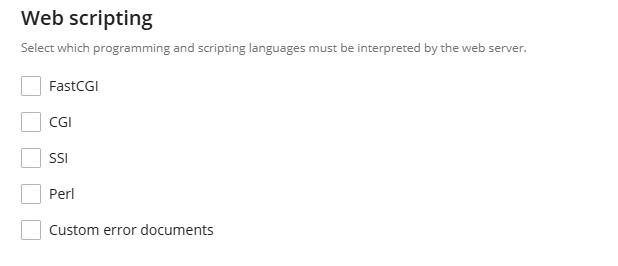Programing and scripting languages
Contents


-
FastCGI is a high-performance interface between web servers and applications, commonly used to run dynamic content. Unlike traditional CGI, FastCGI keeps the application processes alive between requests, which significantly improves performance and reduces server load.
-
CGI (Common Gateway Interface) is one of the earliest methods for generating dynamic web content. Each request spawns a new process, which makes it less efficient than FastCGI, but it's still used for simple scripts or legacy applications that don’t require high performance.
-
SSI (Server Side Includes) allows web servers to dynamically include content (such as headers, footers, or timestamps) into HTML pages before serving them. It's lightweight and useful for basic content templating, but limited in functionality compared to other scripting methods.
-
Custom error documents enable website owners to define their own error pages (e.g., 404 Not Found or 500 Internal Server Error), offering a more user-friendly experience and allowing for consistent branding even when an error occurs.
Web Scripting Configuration in Apache Virtual Hosts
This section outlines what changes are made to the Apache virtual host configuration when enabling each Web Scripting option in Plesk.
FastCGI
When FastCGI is enabled, the following block is added:
<IfModule mod_fcgid.c>
<Files ~ (\.fcgi$)>
SetHandler fcgid-script
Options +ExecCGI
</Files>
</IfModule>What it does:
- Enables execution of
.fcgiscripts. - Applies the
fcgid-scripthandler viamod_fcgid. - Activates
ExecCGIto allow CGI-style execution.
CGI (Common Gateway Interface)
When CGI is enabled, two key changes occur:
1. ScriptAlias is added:
ScriptAlias "/cgi-bin/" "/var/www/vhosts/example.com/httpdocs/cgi-bin/"2. Document-Root Options directive is updated:
Options -Includes +ExecCGIWhat it does:
- Maps the
/cgi-bin/URL path to the physical directory containing CGI scripts. - Enables CGI script execution with
+ExecCGI.
SSI (Server Side Includes)
When SSI is enabled, the document-root Options directive is updated to:
Options +Includes -ExecCGIWhat it does:
- Enables parsing of SSI directives like
<!--#include ... -->inside.shtmlor.htmlfiles.
Perl
When Perl scripting is enabled, the following block is added:
<IfModule mod_perl.c>
<Files ~ (\.pl$)>
SetHandler perl-script
PerlHandler ModPerl::Registry
Options +ExecCGI
allow from all
PerlSendHeader On
</Files>
</IfModule>What it does:
- Enables
.plPerl scripts to be executed viamod_perl. - Wraps scripts in
ModPerl::Registryfor persistent execution (performance boost). - Ensures proper HTTP header handling with
PerlSendHeader On. - Allows public access to Perl script output via
allow from all.
Proxy Mode and scripting in Plesk
You can find the Proxy Mode toggle under:
Domain > Hosting & DNS > Apache & nginx Settings
What Happens When Proxy Mode is Enabled
- NGINX acts as a reverse proxy, serving static files and forwarding everything to Apache.
- Apache processes:
- PHP via FastCGI/PHP-FPM
- CGI scripts
- Perl
- SSI
- Apache
.htaccessrules are applied.
What Happens When Proxy Mode is Disabled
- Apache is completely disabled for that domain.
- NGINX becomes the only active web server.
- NGINX uses PHP-FPM only for PHP processing.
- CGI, Perl, and SSI do not work as these depend on Apache which is no longer used.
- Apache
.htaccessrules are ignored (NGINX doesn’t process .htaccess files). - All scripting functionality tied to Apache configuration is non-functional.
LiteSpeed and scripting in Plesk
If you have the LiteSpeed Extension for Plesk installed, LiteSpeed replaces Nginx + Apache as the main web server. This change affects how scripts are processed.
Key Points:
- LiteSpeed supports Apache configurations, including
.htaccessfiles. - PHP must be run via FastCGI — LiteSpeed does not support PHP-FPM on Plesk.
- LiteSpeed provides better performance under load, lower memory usage, and built-in caching.
- To use LiteSpeed, you need a separate license. You can request a LiteSpeed free trial and a LiteSpeed license via a support ticket.